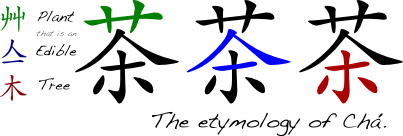The word “Tea” was not always as we speak it now. Where it is pronounced in modern times as “tee,” before the great vowel shift of the English language “ea” was pronounced like the end of “ray,” making “tea” more like “tay.” The only traces of this pronunciation are in proper names like “O’Shea” or “Dunrea.” From there, it traces its origins back to Chinese.
Now, the Chinese character for tea is 茶, but it is pronounced differently in the various Chinese dialects. Two pronunciations have made their way into other languages around the world. The first is te (Taiwanese tê) which comes from the Min Nan dialect spoken around Xiamen (Amoy). This is where the English pronunciation came from. The other is is chá, used by the Cantonese dialect spoken around the ports of Guangzhou (Canton), Hong Kong, Macau, and in overseas Chinese communities, as well as in the Mandarin dialect of northern China. Yet another different pronunciation is zu, used in the Wu dialect spoken around Shanghai.
The character, itself, is made up of three lesser characters or radicals. The crosspiece on the top is the abbreviated form of 艸 căo, which means “grass” or “plant.” Directly under it we see the radical 亼 jí, which is an old primitive form of a mouth. Finally, under that, sharing the cross-piece, we find the radical 木 mù, which means “tree.” Putting these three together, we can see that 茶 came from the concept of a plant which was an edible tree.
茶 (chá) originally came from the ancient character 荼 tú, pictured above, which features the same radicals, although completely differentiated.

